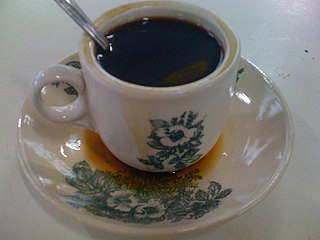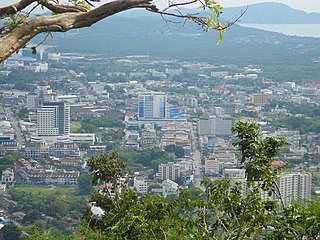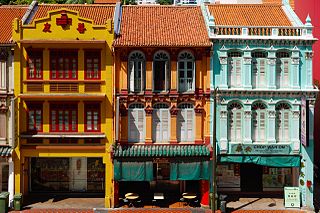
Phuket is one of the southern provinces (changwat) of Thailand. It consists of the island of Phuket, the country's largest island, and another 32 smaller islands off its coast. It lies off the west coast of mainland Thailand in the Andaman Sea. Phuket Island is connected by the Sarasin Bridge to Phang Nga province to the north. The next nearest province is Krabi, to the east across Phang Nga Bay.

North Point is a mixed-use urban area in the Eastern District of Hong Kong. Located in the northeastern part of Hong Kong Island, the area is named after a cape between Causeway Bay and Tsat Tsz Mui that projects toward Kowloon Bay.

Chinese Malaysians, also commonly called locally as Malaysian Chinese, are Malaysian citizens of Han Chinese ethnicity. They form the second-largest ethnic group, after the Malay majority, and are 22.8% of the Malaysian population. Most of them are descendants of Southern Chinese immigrants who arrived in Malaysia between the early 19th and the mid-20th centuries. Malaysian Chinese form the second largest community of Overseas Chinese in the world, after Thai Chinese. Malaysian Chinese are traditionally dominant in the business sector of the Malaysian economy.

Chinatowns in Asia are widespread with a large concentration of overseas Chinese in East Asia and Southeast Asia and ethnic Chinese whose ancestors came from southern China—particularly the provinces of Guangdong, Fujian, and Hainan—and settled in countries such as Brunei, Cambodia, East Timor, Indonesia, India, Laos, Malaysia, Myanmar, the Philippines, Singapore, Sri Lanka, Thailand, Vietnam, Japan and Korea centuries ago—starting as early as the Tang dynasty, but mostly notably in the 17th through the 19th centuries, and well into the 20th century. Today the Chinese diaspora in Asia is primarily concentrated in Southeast Asia; however, the legacy of the once widespread overseas Chinese communities in Asia is evident in the many Chinatowns found across East, South and Southeast Asia.

Sungai Lembing is a small town in Kuantan District, Pahang, Malaysia. It is about 42 km northwest of Kuantan. The town was founded in the 1900s as a tin mining community when the British company Pahang Consolidated Company Limited (PCCL) set up the tin mining industry there after mining activities had begun in 1886. Sungai Lembing had electricity, schools, a cinema, its own petrol station, and a hospital.
Tiong Bahru is a housing estate located within the Bukit Merah Planning Area, in the Central Region of Singapore. Tiong Bahru was constructed in the 1920s by the Singapore Improvement Trust, the predecessor to the Housing Development Board (HDB) and an entity of the British colonial authority providing mass public housing in Singapore and is the oldest housing estate in Singapore. The main estate consists of 30 apartment blocks with over 900 units of two to five rooms that are also commonly referred to as "walk-ups". There are also high-rise HDB flats and condominiums along Boon Tiong Road, Jalan Membina and Kim Tian Road which surround the main estate.

Petaling Street is a Chinatown located in Kuala Lumpur, Malaysia. The whole vicinity is also known as Chinatown KL. Haggling is a common sight here and the place is usually crowded with locals as well as tourists.

Hội An, formerly known in English as Fai-Fo or Faifoo, is a city with a population of approximately 120,000 in Vietnam's Quảng Nam Province and has been noted as a UNESCO World Heritage Site since 1999. Along with the Cù Lao Cham archipelago, it is part of the Cù Lao Cham-Hội An Biosphere Reserve, designated in 2009.

Yue Hwa Building is a historic building located at the junction of Eu Tong Sen Street and Upper Cross Street in Chinatown, Singapore, next to Chinatown MRT station. Built by Swan and Maclaren in 1927, it was then the tallest building in Chinatown and was known as Nam Tin Building (南天大厦), owned by Lum Chang Holdings. The building housed the six-storey Great Southern Hotel, along with a few shops and cabarets that were popular among Chinese travellers. In 1993, Lum Chang Holdings sold the building to Hong Kong businessman Yu Kwok Chun, who converted it to the first Yue Hwa Chinese Products department store in Singapore in 1994. The renovation process, which conserved the exterior while adding features such as an atrium and waterfall to the interior, won the building the Architectural Heritage Award by the Urban Redevelopment Authority in 1997.

Krásno is a town in Sokolov District in the Karlovy Vary Region of the Czech Republic. It has about 700 inhabitants. It is historically associated with tin mining.
Bangkok, the capital of Thailand, is one of the world's top tourist destination cities. Each year, approximately 22.7 million international visitors arrive in Bangkok. MasterCard ranked Bangkok as the world's top destination city, with 15.98 million projected visitors in 2013. It topped the MasterCard Global Destinations Cities Index as the most visited city in the world in 2012, 2013, 2016, 2017 and 2018. The city is ranked fourth in cross-border spending, with 14.3 billion dollars projected for 2013, after New York, London and Paris. Euromonitor International ranked Bangkok sixth in its Top City Destinations Ranking for 2011. Bangkok has also been named "World's Best City" by Travel + Leisure magazine's survey of its readers for four consecutive years since 2010.

Kopi, also known as Nanyang coffee, is a traditional coffee beverage found in several Maritime Southeast Asian nations. Often brewed to be highly caffeinated in strength, it is commonly served with sugar and/or milk-based condiments. This drink originated from the British Malaya era, with Hainanese cultural roots. The name of the drink is derived from the Malay term for coffee. The term Nanyang, which means "South Sea" in Mandarin, refers to Maritime Southeast Asia. Kopi culture vocabulary is grounded in Hokkien dialect as a result of historical immigration to Maritime Southeast Asia from the Minnan region in the south-eastern part of Fujian Province in Southeastern Mainland China. The beverage is usually served in coffee shops, Hawker centres and kopitiams across the region.

Kampung Cina, is a Chinatown located in Kuala Terengganu, Terengganu, Malaysia. Kampung Cina is located along Jalan Bandar, in Kuala Terengganu city centre at the river mouth of Terengganu River that empties into the South China Sea. Kampung Cina literally means Chinese Village; it is also called Tn̂g-lâng-pho (唐人坡) or KT's Chinatown by local people. It is one of Southeast Asia's early Chinese settlements and contains stately ancestral homes, temples, townhouses, and business establishments. The town is small but has colourful shophouses along both sides of the road that carries traditional flavour.

Phuket is a city in the southeast of Phuket Island, Thailand, and the capital of Phuket province. As of 2020 the city had a population of 79,308. It covers the subdistricts (tambons) Talat Yai and Talat Nuea of Mueang Phuket district.

O-aew is a shaved ice dessert known as a local specialty of Phuket, Thailand. Introduced by Hokkien Chinese settlers, it is known after its main ingredient, a jelly made from seeds of the o-aew plant, an ingredient now most commonly found in Taiwan where it is known as aiyu jelly.

Phuket FantaSea is a Thai nighttime cultural theme park located on the island of Phuket, in the south of the country. The park covers an area of 60 acres and includes a Thai culture theatrical show, a theme buffet restaurant, and a shopping street. The park was created at a cost of over THB 3,500 million and was opened to the public on 20 December 1998.

Sino-Portuguese architecture, also known as Chinese Baroque,Straits/Singapore Eclectic architecture or Peranakan architecture is an Asian hybrid style incorporating elements of both Chinese and Portuguese architectural styles. It is common in urban centers where Chinese settlers lived in southern China and the Peranakans of the Malay Peninsula, with examples found and most prominently conserved and maintained in Singapore.

Kudi Chin or Kadi Chin, also spelled "Kudee Jeen", etc. is a historic neighbourhood in Bangkok. It is in Wat Kanlaya Sub-district, Thon Buri District, on the west bank of the Chao Phraya River, south of Bangkok Yai Canal. The neighbourhood, dating to the Ayutthaya period, includes communities of several faiths living in close proximity. Today, it is best known for the Catholic community around Santa Cruz Church, but the wider neighbourhood also includes the areas around Wat Kanlayanamit, Kudi Khao Mosque, and the Chinese Kuan An Keng Shrine. Conservation and revitalization efforts beginning in 2008 have made the neighbourhood a cultural tourism destination.

Chanthaboon Waterfront Community or Chanthaboon Riverside Community is an ancient waterfront community in the heart of Mueang Chanthaburi District, Chanthaburi Province in eastern Thailand. It is sometimes also written as Chantaboon Waterfront Community.
Ban Singh Tha is a historic neighbourhood of Mueang Yasothon District, Yasothon Province, Isan, regarded as an old town zone that is filled with ancient buildings that remains the same in the past. It is surrounded by Sri Sunthon, Nakhon Thum, Uthai Rammarit and Witthaya Thamrong Roads.


















